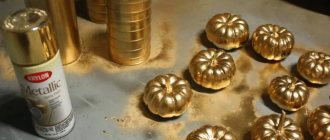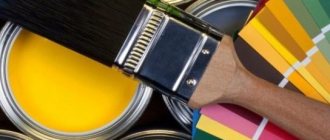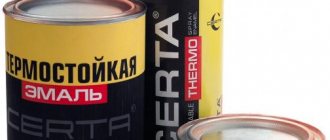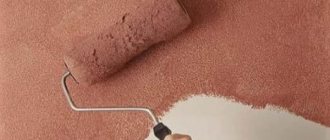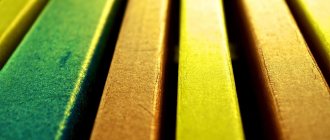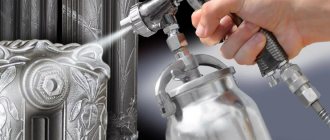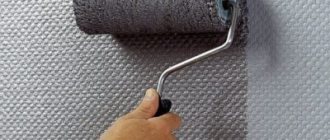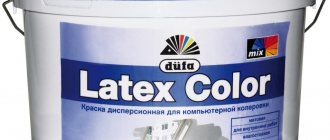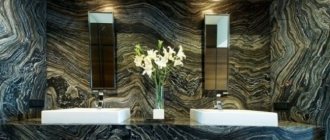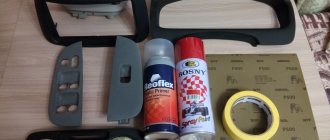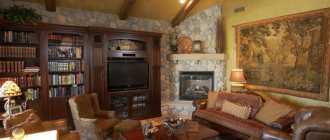Areas of application
Paint with a reflective effect is used for marking or decoration purposes, respectively, where reflection of light is required.
A nice feature of this material is that it dries quickly even in harsh climatic conditions. To make the reflection effect more pronounced and lasting, a primer is usually used before applying paint. If reflective material is used for decoration, then it is recommended to additionally apply a colorless varnish on top of its coating - this will not only consolidate the effect of light reflection, but also give the surface a glossy texture. The most widely used is aerosol reflective paint in cans. This is due to the fact that its application does not require much labor, special skills or significant time investment. The main advantage of aerosol varnish is that it is ready for use immediately after purchase. But regardless of the external form, be it a can or a jar, compositions with the property of “glow in the dark” are used to solve many problems, including:
- creation of markings near schools and on the territories of enterprises;
- applying markings to vehicle elements;
- painting helmets or uniforms of motorcyclists and cyclists;
- decoration of facades, for example, facing tiles, panels or ordinary concrete surfaces;
- designation of road signs and highway surfaces;
- decorating the premises of private houses, clubs, bars and various entertainment venues;
- creating works of art - from glow-in-the-dark paintings to spectacular body art (in the latter case, special coloring compounds are used that meet a number of hygienic standards).
The increasing popularity of reflective varnish is influenced by the fact that roads are filled with an increasing number of cars. Thanks to the varnish, movement on and near roads in the dark becomes safer for both pedestrians and drivers. Therefore, light reflective coating becomes not a luxury, but a concern for lives. In order to understand this more deeply, it is enough to imagine how the situation will change if the road, its markings and signs cease to be noticeable.
An advantage to all of the above is that a coloring mixture with a similar effect can be easily created with your own hands at home. And, of course, you can use it for your own purposes, not necessarily related to road traffic. There's nothing complicated about painting simple, portable objects such as children's toys - it will give the child the opportunity to look at them in a completely new way under the cover of darkness. The main thing is that because of the interest he shows, you don’t have any difficulty sending your baby to bed. Another option is to make a luminous drawing on the wall so that the child is not afraid to sleep in the dark.
Main varieties
There is no officially accepted classification of this paint. But based on the type of active substance, the following types can be distinguished:
- Fluorescent. Its glow appears only in ultraviolet rays. It is often used in exterior decoration, nightclubs and for car tuning. Acrylic varnishes are used for it, which makes the enamel environmentally friendly for human health. Glow-in-the-dark pigments come in a variety of shades. But the most spectacular are green, yellow, pink and red tones.
- Luminescent. This is the most common paint that glows in the dark. She only needs 20 minutes of exposure to daylight or artificial light. Then the resulting surfaces glow in the dark throughout the night. It is usually used as road markings or on barriers at construction sites. Once applied, photoluminescent paint significantly increases safety at industrial facilities.
- Phosphorizing. Due to its phosphorus content, it is hazardous to health. Because of this, it is rarely used and only for painting external elements of buildings and cars. If possible, it is replaced with other types of finishes with luminous elements.
Based on the degree of transparency of the pigment, there are translucent enamels, almost invisible in daylight, and colored enamels, which are visible in the daytime and have a wider color spectrum.
When choosing paint, focus on the coating material. For PVC surfaces, a dye with polyurethane-mineral resins is suitable, as they enhance adhesion. Water-acrylic enamel is often used to paint flower beds. It does not harm plants. And for pools and drains, a waterproof base containing fluorescent ink is suitable.
On video: characteristics and application of luminous paint.
Composition and characteristics
Any reflective varnish owes its “magical” properties to a special pigment in the form of a ball, which is mixed with a transparent varnish. The task of pigments is reduced to the following: beams of light entering them are reflected, as a result of which the painted surface glows.
It is generally accepted that the ideal proportion of pigment balls and a binder in the form of varnish for working with an aerosol spray gun is 1:3 (where 1 part is pigment, and 3 parts are dye). However, some people mistakenly believe that the more light-returning balls, the better the glow effect. But that's not true. There is a clear proportion, tested by the hands of professionals and many years of experience, which is better to adhere to. If dilution is necessary, use toluene or xylene.
The composition of varnishes with a glow effect differs in the basis of each of them, and you should focus on it before purchasing and carrying out work. The varnish base must be chosen depending on the type of surface to be coated: concrete, plastic, metal, wood, glass or road surface.
The packaging of the painting product must contain detailed information about the composition and surfaces for which it is intended. For example, when working with concrete, you should give preference to acrylic-based paint, and when working with metal, you should give preference to alkyd-based paint. For the reflective balls themselves, it does not matter what base they are mixed with, be it alkyd, polyurethane or acrylic varnish - their properties do not change.
The average consumption of coloring materials with a reflective effect is 250 grams per 1 square meter. The average drying time at a temperature of 22 degrees Celsius, as a rule, does not exceed 60 minutes. Prices for both aerosol products and those applied with a brush vary greatly, making it difficult to give them an unambiguous assessment.
Not just by eye
The possibilities of visual analysis are limited mainly by qualitative assessment: “there is a glow - there is no glow.”
Much more information is provided by quantitative characteristics (see the chapter “The language of fluorescent reporters”). Two methodologies are used to quantify fluorescence. The first serves to measure various fluorescence characteristics in a relatively large (macroscopic) area of an object, which provides average characteristics for the object: solution, suspension of colloidal particles, cells, subcellular particles, etc. The second is focused on single microscopic objects, primarily cells and subcellular particles.
Integral fluorescence measurements are carried out using spectrofluorimeters (fluorescence spectrophotometers) and plate fluorimeters
). Spectrofluorimeters are, as a rule, analytical instruments that can be used to obtain all the main characteristics of fluorescence. Tablet fluorimeters are devices for analyzing a large number of samples (sometimes more than thousands), but only according to several fixed characteristics, for example, fluorescence intensity in a certain spectral region and/or the lifetime of fluorophores in the excited state. Most techniques using plate fluorimeters are based on immunological reactions or on the analysis of the development of cell cultures in monolayers.
The methodology for measuring the fluorescence of single microscopic objects also has two options.
Confocal microscope
The first is based on obtaining digital images of objects followed by computer analysis. The second is on a “piece by piece” measurement of the fluorescence of microobjects in a flow, when passing through a narrow capillary of a special device - a flow cytometer.
Fluorescence microscopy has recently undergone a real revolution: new devices have been developed, primarily confocal microscopes, in which fluorescence is excited and recorded through a microscopic hole that cuts off the “extra” glow that occurs outside the focus of the lens. This “pupil” scans the image in the horizontal and/or vertical plane, the signals are recorded by a photomultiplier, and after computer processing, a spatial image of the object is obtained. This design allows for sharper 2D and 3D images than standard microscopes. In addition, modern confocal microscopes can measure fluorescence decay parameters.
Another type of “revolutionary” microscope operates seemingly contrary to the basic physical principles of fluorescence. The atoms in them are excited by light with a wavelength longer than that of fluorescence, not shorter. In fact, no laws of physics are violated during the operation of these microscopes; simply, with sufficient intensity of the light flux with a longer wavelength, two photons can simultaneously hit the same atom, the energy absorbed by the electrons doubles, and it is sufficient to excite fluorescence. Therefore, such microscopes are called two-photon microscopes. And since the light flux is maximally concentrated at the focal point of the lens, high-resolution images are ensured. Two-photon microscopes are also distinguished by their ability to record fluorescence in samples at a depth of up to 1.5 mm and the ability to significantly reduce the adverse effect of exciting radiation on both the objects under study and fluorescent reporters.
Quantitative information is extracted from digital images using computer image analysis programs. The fluorescence intensity and its spatial distribution are measured, the spectral characteristics of the radiation are assessed, the number of fluorescent particles, such as cells, is determined, and the temporal and polarization parameters of fluorescence are characterized. Special analytical techniques (so-called fluorescence correlation spectroscopy) allow the use of confocal and two-photon microscopy to study the movement of even single fluorescent molecules!
Manufacturers
There are many manufacturers of glowing paints on today's market, and many of them produce quality products.
One of the most worthy brands is Revell. This brand was created in America in 1943. At first, his products were plastic toys and doll furniture. The company expanded, merged with others, including European companies, and the company's product range grew. Revell began producing prefabricated models of cars, ships, and airplanes. The product was a huge success. In addition to model kits, the company has launched the production of all the necessary accessories for assembly. Among them were paints, brushes, sprayers.
Revell is constantly developing, studying global experience, modernizing and expanding production. Taking care of her clients, she develops interesting programs with bonus points and promotions. Bonus points can be used to pay for some purchases. The company's consultants are always in touch and help customers choose goods that will be delivered to any corner of Russia.
The line of luminescent paints is represented by water-based acrylic compositions. Environmentally friendly materials are used for their production. They are suitable for decorating children's toys. When applied, a thin, even layer is obtained, which dries quickly and makes it possible to apply the next layer.
The paint has no pungent odor and is not flammable. If necessary, you can easily mix different tones. Luminescent yellow, silk-matte red, and matte orange paint look especially beautiful.
Some companies not only produce paint, but also produce luminous products. Noxton is among the leaders. It offers the widest selection of paint compositions of various types (luminescent, fluorescent, reflective) for various surfaces and for a variety of purposes.
Noxton paints are economical and safe, have a very long service life, and high-quality dyes are used for their production.
Noxton also offers a large range of finished products (more than 40 directions), among which you will find:
- luminous self-adhesive film;
- safety signs and vests;
- nail polish and hair gel;
- souvenirs;
- paintings;
- items for interior decoration;
- items for different areas of design.
It has proven itself well, existing since August 2011. The company produces and sells luminous paint and aerosols, special pastes and liquids for mirrors and glass. The company also sells luminous products that can transform different rooms.
One of the areas of her activity is the production of luminous paintings. They are suitable for any interior and make it mysterious at night. "Fairytale World", Magic Crow, "Leopard" are full of charm and magic.
The paintings can be charged by any light or heat source in a few minutes, and they will glow for 10-12 hours. The glow can be blue or green. Manufacturers promise this function to work for up to 100 years.
Even more options for using glowing paint are presented in the video below.
Features of luminous paint and its varieties
Luminescent paint has special properties that give it a glow in low light and at night. For some time it accumulates light and then releases it over the course of 8-12 hours. This allows you to create different effects on the treated surface. You get original lighting effects or images. This way you can create a single light accent or an entire composition.
Peculiarities
Fluorescent paints also emit light during the daytime. However, in the dark their light becomes 3 times brighter and more saturated. For this reason, this paint is often chosen for night decoration and various types of markings. To make surfaces coated with this paint look stylish even during the day, you can use colored fluorescent products.
They can be white, blue, green, red, brown or light blue. Transparent colors will be almost invisible during the day. This dye will not glow on its own. When exposed to ultraviolet rays, its bright glow will increase tenfold.
If you don’t know how fluorescent paint differs from its luminescent counterpart, you should take note: the latter has an independent illumination effect. The duration of this effect can last up to 10-12 hours. Over the course of a whole day, painted surfaces absorb light; with the onset of darkness, they begin to glow autonomously. This difference allows you to accurately select the right type of paint.
There is also reflective dye. It acts as a reverse reflection of the light flux: as soon as the light hits the painted surface, the rays are immediately reflected at a distance of 200 - 250 m. This paint is selected to increase safety on the roads.
Different types of fluorescent materials are suitable for coloring:
- metal products (they can be used to cover car rims, road signs, and various objects);
- different fabrics (depict designs on clothes, use for advertising purposes);
- glass and ceramic products (this could be tableware or stained glass painting);
- the human body (can be found in body art) and on the leaves of ordinary plants;
- wood (you can paint fences, decorate gazebos, window and door openings);
- stone and concrete (painting walls, garden paths, city alleys, building facades);
- plastic (products made of PVC, polystyrene and other plastic materials).
In addition to the ability to glow beautifully, fluorescent materials have other characteristic features. Among them there are both advantages and disadvantages. Let's look at the key points.
Low light fastness
Fluorescent paints can fade in a matter of months when exposed to light (if used externally). To make the dyes fade more slowly, a modifier is introduced into the product, which absorbs UV rays. In addition, the coating with already applied paint can be painted over with transparent varnish. But the brightness of the paint will be reduced.
Loss of quality due to incorrect tinting
A fluorescent coloring product will become extremely unstable after unsuccessful tinting. To give the surface durability, it is better to immediately buy ready-made material in the desired color.
Grain
Since the pigment grains are too large, they will not allow you to achieve a completely glossy finish. To solve this problem, the dye is applied in 2 layers or painted over with varnish.
Fear of excessively high temperatures
Fluorescent paints and varnishes disintegrate at temperatures of +150 – 250 degrees C. They completely lose their ability to glow brightly.
You only need 15 minutes of bright daylight or artificial light to charge the applied paint for 8 full hours of use. The process of light accumulation is a completely continuous cycle. Product manufacturers guarantee that their luminous paints will work for at least 30 years.
How is it different from fluorescent?
Glowing colors have long taken their place of honor in the modern world, settling forever in many industries and areas. There are simply no limits to the use of paints today - they are used on land, under water, in space.
There are two types of luminous paint and varnish coatings, which have significant differences:
- luminescent;
- fluorescent.
Luminescent paint is a paint and varnish material based on a phosphor. Products or surfaces painted with it glow in the dark. Often used by artists to create drawings and paintings. The pigment it contains is powered by solar energy or bright artificial lighting throughout the day, and at night it illuminates the painted surface and everything around it.
We recommend: DIY refrigerator painting
The features of this paint include:
- pigment size equal to five microns;
- smoothness and perfect evenness of the surface on which the paint is applied;
- half-hour recharge for 12-hour glow;
- the presence of a greenish and bluish glow, which is present due to the phosphor;
- long paint life, up to 30 years;
- frost resistance;
- moisture resistance;
- absence of toxic substances that negatively affect human health;
- high cost.
Fluorescent paint is a coloring material that is not powered by solar energy, but shines when exposed to ultraviolet rays. The fluorescent contained in the composition does not glow, but only reflects the light spectrum.
The features of this paint are:
- continuous glow under the influence of ultraviolet rays;
- the color palette includes eight bright colors, as well as many different shades that are formed when mixing paints;
- the pigment size of the finished paint reaches 75 microns;
- when exposed to sunlight, fluorescent paint fades and fades;
- cannot withstand high temperatures and simply collapses when exposed to extremes;
- affordable price segment.
If we talk about whether luminous paint is harmful to health, the answer is obvious - no, so its range of applications is very wide.
Fluorescent paint
Many people can answer the question of what kind of paints these are. Indeed, fluorescent paints belong to decorative paint and varnish material, which has a unique reaction to the influence of light flux. Products coated with this composition are visible in any lighting. Moreover, at night they are much brighter than in the daytime. Professionals emphasize that the glow is almost twice as intense.
The high demand for similar materials is naturally explained by the unusual effect and therefore the paints were quickly noticed.
Fluorescent luminous paint
The variety of paints offered has a wide range. You can choose from white, brown, red, blue, yellow, green paints. Interestingly, they can be visible or invisible. Invisible paint has the peculiarity that it is almost impossible to see it in the daytime. It only appears when exposed to ultraviolet rays.
Visible paint is easy to distinguish, however, when exposed to sunlight, the glow intensifies.
The most common fluorescent coloring composition is acrylic, the base of which is water-based. The composition includes a dye, a binding element (acrylic polymer emulsion) and water prepared in a special way. Those who have used this composition note the uniqueness of the product.
The advantages of the material include:
- Versatility - can be used both indoors and outdoors.
- Ease of use - when performing work, a spray bottle, brush, paint sprayer or roller is enough.
- Saturation of the painted surface - additional protection from adverse weather conditions can be achieved using a polyurethane-based varnish.
- It fits well and economically on the surface.
- Dries quite quickly.
- Impeccable consumer properties - do not tarnish, the color does not lose color under the influence of sunlight.
- Do not harm human health.
- A diverse range of applications - you can paint paper bases, fresh flowers and wood, concrete and stone surfaces, plastic and metal.
The use of dyes with fluorescent special effects is quite widespread.
The unusual property of the material can be successfully used as:
- Marking – designation of signal strips and signs on transport.
- Painting of various objects - equipment, road signs, "beacons".
- Marking of pipeline fragments, machine tools, equipment that have hazardous areas.
Luminescent paint
Luminescent paint is a substance that has a special effect. Using it, we can solve several problems at once. The painted layer is a barrier between the base and the microclimate of the room. In other words, the characteristic “aromas” that primer and plaster compositions possess will not enter the room. Dust will not be generated, which usually occurs during construction work.
The surface to be painted will be reliably protected from humidity and temperature changes. Processing and caring for such surfaces will not be difficult. You can carry out wet processing using chemicals.
Modern paints and varnishes can give the surface to be painted any microtexture. The main direction is to give the sample a beautiful appearance. You can get a smooth or rough effect. And if we talk about color, there are simply endless possibilities. Modern technologies in the production of paints and varnishes even make it possible to create a pearlescent video effect. Such a coloring substance is capable of changing the color background depending on the brightness of the light flux. This special effect can be achieved thanks to the special additives contained in the composition. The surface coating method has an influence.
The use of multi-color paints and varnishes makes it possible to obtain a spot image. The result is a unique pattern with unique colors.
Well, a completely new direction in the world of paints - a coloring material with a luminescent effect.
Translated from Greek, phosphor is a composition that carries light. The uniqueness of the material lies in its ability to transform absorbed light energy into a luminous stream. This is the main difference between luminescent paints. And most importantly, they do not contain toxic substances that are present, for example, in phosphorus paints.
Luminescent paints are used mainly to create luminous inscriptions on items of clothing, shoes, and student bags. You can’t do without these paints when producing advertisements, souvenirs, and Christmas tree decorations. One of the new areas for using such paints is makeup or body art. Special mixtures have been created that are safe for humans and can be applied to the skin.
The glow of luminescent paint is observed in the dark due to ultraviolet rays absorbed during the day.
If you look carefully, you can say that adding phosphor powder to ordinary varnish or paint gives a glowing effect. Elements of the lanthanide group and aluminum oxide are capable of activating the glow.
Various materials can be treated with luminescent paint. Almost all surfaces that surround us at home and on the street can be painted with this paint. Moreover, in addition to uniqueness, painted materials increase functional characteristics. The release form of such paints is different - you can buy it in a can, or you can find it in a spray - it all depends on where you will use it.
General disadvantages
Unfortunately, coatings cannot fluoresce forever, since they have rather poor resistance to direct sunlight. You can avoid rapid fading by using protective agents, such as clear varnishes.
When purchasing such a composition, it is important to make sure that it does not have matting properties, which will significantly reduce the glow effect. The texture of the fluorescent dispersion does not allow achieving a glossy surface finish. When such a need arises, you can resort to the method described in the previous paragraph. The material does not apply to heat-resistant compounds
Destroys at a temperature of +100-150 °C.
Types of phosphor
According to its chemical composition, the substance is divided into inorganic (most of them are crystal phosphors) and organic.
Inorganic phosphors
Their glow is often caused by the presence of cations. They are used in fluorescent lamps, cathode ray tubes, used in the manufacture of X-ray screens, serve as radiation indicators, etc.
Organic phosphors
Organic phosphors are used to make fluorescent paints and luminescent materials. They are also used for luminescent analysis by chemists, biologists, doctors and criminologists.
According to their characteristics, phosphors are divided into:
- Photoluminescent phosphors
- Electroluminescent phosphors
- Cathodoluminophores
- X-ray phosphors
- Radioluminophores
The most widely used is photoluminophore - a type of phosphor that has certain properties and retains energy for a long time. After its accumulation, the phosphor can emit it for a long time in the form of radiation - ultraviolet, infrared, or that which is visible to the human eye.
It is the photoluminophor type phosphor that you can make with your own hands.
Kinds
Since there is no official classification, the type of paint can be determined not only by the active pigment, but also by the surface on which it is applied. Different compositions can be used for the same surface.
Phosphor paint is suitable for coating various materials. It can be used to apply designs to metals, fabrics, glass, wood, concrete, and plastic. It quickly accumulates light energy and then releases it over many hours, providing a beautiful phosphorescent glow.
Since prolonged contact with phosphorus can cause nausea and more severe poisoning, in modern paints phosphorus is replaced with a phosphor that acts in a similar way.
The phosphor is a phosphorescent powder, so paint with it is called phosphorescent.
Also, paints in which the pigment can accumulate both solar and electric light and then release it are called luminescent. The color at night may be different from the color the paint is during the day.
The undoubted advantage of luminescent paints is their harmlessness. And since they are made on the basis of varnish, they have another remarkable property: by creating a film on the surface to be painted, they protect the object from humidity and other adverse environmental influences.
For some people, luminous floral paints are of particular interest. They are designed to create a glow effect on fresh flowers.
It can be used to treat any parts of plants: petals, leaves, buds. And it will even extend the life of cut flowers.
It can be applied in any way. During daylight hours it will look like a light white coating. Any light source will “charge” it.
A slightly different type is fluorescent paints. They can be any color and look like regular paint. Neither day nor night they differ from ordinary coatings. They require a source of ultraviolet light to glow. They can be used on wood, concrete, paper, metal or plastic. In order for their effect to appear, one layer is enough.
The base for fluorescent compositions can be of any color, they can even be applied to other designs made by conventional means. Fluorescent paints do not harm health, so they can be used in homes and places where large numbers of people gather.
Some modern manufacturers are mastering the production of compositions in which the glow effect appears as luminescent with gradual attenuation and as permanent when irradiated with ultraviolet light.
Manufacturers produce phosphorescent paints in different containers: cans and spray cans.
Aerosol paint is more popular due to the following properties:
- it is easy to use;
- this is a ready-made composition, there is no need to add solvents or other substances to it;
- you can quickly paint a large surface with it;
- it dries quickly.
Application instructions
The method of applying fluorescent watercolor depends on the condition of the surface. It can be embossed or smooth, rough or smooth. Tools that can be used: paint brush or paint roller, foam swabs or paint sprayers. To make the painting process easier, you can purchase foam holders. Watercolor can be splashed on the wall, and small objects can be dipped into the paint.
You can also paint the wall with fluorescent paints from a spray can. These are produced by KUDO or BOSNY.
Direct application of enamel is carried out according to the following rules:
- First, the surface is thoroughly cleaned of dust and dirt. You can wash it with soap or clean it with baking soda. We emphasize that the surface should then be thoroughly dried.
- Before applying the enamel, stir it well. If a dispersion emulsion is used, then 10% water is added to it. If painting is done from a spray can, shake it well for about 2 minutes.
- Coloring must be done at a temperature not lower than 50C.
- Fluorescent paint is applied in several layers. If a brush or roller is used, then the first layer should be applied in this direction, and each subsequent layer in a perpendicular direction. Enamel from spray cans is applied at a distance of 25-30 cm from the surface to be painted.
- Don't forget to let each layer dry for about 3-4 hours before applying the next one.
- The last layer is applied on top of several previous ones, which means that more time must be given for drying, about a day.
Advice! To make it easier to apply your own designs, you can use stencils or ready-made stamps. More complex compositions must first be drawn on the wall with a pencil, and only then painted.
General recommendations for the use of fluorescent paint
The application of luminous enamels is no different from any other type of painting work. Of course, the specifics of application are influenced by the composition, purpose and type of surface to be painted.
There are several general recommendations:
- purchase of standard equipment and additional materials: brushes, rollers, spray gun, protective equipment, solvent;
- surface preparation: remove dirt, dry and degrease;
- paint preparation: stir the composition until smooth, add thinner/solvent if necessary (according to the instructions);
- application of the material: usually, it is recommended to apply the fluorescent composition in 2-3 layers to form a high-quality and durable coating. Each layer needs to be allowed to dry a little.
Conclusion
So, now you know the answer to the most popular question - does fluorescent paint glow in the dark or not. By choosing a high-quality source of ultraviolet radiation, you can create a unique interior, as well as give an unusual look to your own clothes, car or even hair. Go for it!
Rating of the best manufacturers
The most famous manufacturers of aerosol paints are (Kudo brand) and the Taiwanese company RJ London Chemicals Industries Co.,Ltd. (trademark Bosny).
The high quality of fluorescent paints is guaranteed by the following companies:
- NoxTon (Ukraine);
- New Ton (Ukraine);
- AcmeLight (Ukraine);
- "Champion" (USA).
Russia, Poland, Ukraine are leaders in the production of fluorescent enamels.
Application technique
Most often, such paints and varnishes are applied to facade parts and various protruding parts of structures. Reflective pigment is the main distinguishing feature of their composition, which eliminates the need to use additional decorative layers. All that is required for liquid formulations is to mix them first. Before using materials in tubes or cans, you don’t even need such a small thing - they are ready for use from the very beginning.
But first, take care of the surface you are going to apply paint to. As with any painting and finishing work, you need to remove any foreign elements from the surfaces, such as dust, rust, grease stains and dirt
If you are going to apply paint to the road surface, then pay attention to pieces of earth and clay - they need to be removed to the base
If the area to be painted is small, then it is advisable to use aerosol reflective varnish in cans. Otherwise, you will need any of the common painting tools - a brush, roller or spray gun. Moreover, the latter is used for working only with fairly liquid compositions. There are then 3 options:
- Mixing a varnish base with reflective balls and color. This method is not designed to produce a thick consistency and can effectively use a paint sprayer;
- The base in the form of varnish is applied to the surface separately from the entire composition, and pigment balls of the desired color are scattered from above using a sieve onto the varnished areas. Excess balls are removed (a jet of compressed air does an excellent job of this). Half of the remaining pigment is not painted over, that is, the previous layer of varnish serves as its adhesive base. This method is used in large-scale road markings;
- White varnish is applied to the surface like a primer, and after it dries, a colored reflective layer is applied.
It is recommended to carry out all work with reflective paint at low air humidity and room temperature. To increase the resistance of the reflective coating to wear, the composition additionally includes quartz sand (with a grain size of no more than 0.2 millimeters and in a proportion of up to 1/100 of the total mass).
Paint application technology
To create a coating on a wall or any other object, several important conditions must be met:
There should be no dust or moisture on the surface to be treated. Dark and black areas are pre-primed or painted white.
When a transparent dye is applied to a colored surface, the spectral transformation of the UV rays changes. To obtain an accurate color, the substrate is bleached.
There should be no dust or moisture on the surface to be treated.
Surface preparation
Before painting, the surface is washed, the old coating is removed, clean objects must be degreased using solvents, then washed and dried well so that no traces of moisture remain.
Before painting, the surface is washed, the old coating is removed, and clean objects must be degreased.
Coloring
Fluorescent paint or enamel is applied with a brush, spray gun or roller. To paint small objects of complex shape, use a sponge or cuvette. Thickened compositions are pre-diluted to the consistency of liquid sour cream. Before applying paintwork materials, be sure to mix them.
When using stencils, the borders are glued with masking tape. Two-layer coatings are applied in perpendicular directions.
Fluorescent paint or enamel is applied with a brush, spray gun or roller.
When choosing a coating, it is important to know exactly what the luminous paint is called. Traditional fluorescent bright green color goes well with yellow and orange. You can create compositions that glow in the UV spectrum on facades, bodies, and walls.
Types of paints
Today, there are two widely known types of coloring mixtures with the effect of light reflection. All of them, at first glance, are very similar, but each product has its own advantages, operating conditions and its own mechanism of the glow phenomenon. Before purchasing it, it is better to familiarize yourself with information about each of these types.
Luminescent varnishes
Luminescent varnish accumulates light from the sun and artificial illuminators, and then reveals it in the dark for 8-12 hours. It reflects soft, eye-pleasing light without even requiring additional ultraviolet exposure. Thanks to the phosphor, light energy accumulates throughout the day, working autonomously in the dark and thereby allowing partial savings on electricity. As a rule, the colors issued are green, blue and milky.
Due to the fact that the pigments of such varnishes sometimes contain harmful substances, the use of luminescent compounds is limited. There is an opinion that they should not be used in bedrooms, children's rooms and kitchens. This is not always justified and relevant only if phosphorus acts as an accumulator in the composition - in this case, it is better to use the coloring material only in outdoor decor, outdoors.
Fluorescent compounds
Paints and varnishes of this type work somewhat differently: their coating does not accumulate light energy, but exhibits a glowing effect only when rays of sunlight or artificial light hit it. An example of this effect can be seen on the road at night, where road signs, indicators and markings begin to glow when hit by headlights.
Fluorescent dyes are used not only for roads, but also for clothing. For example, in some cases they are used to paint work clothes. This type of paint is also in demand when decorating the premises of entertainment establishments, where when ultraviolet lamps are turned on, the painted interior takes on an extraordinary appearance.
Classification of paints
Self-luminous dyes can be classified according to various criteria, for example, according to the type of substance on which the paint is applied:
- Metal - original patterns are created on the surface of the car, you can paint car wheels that will glow, used in interior decoration, for external facade decoration.
- Fabrics - used in the production of manufactured goods, wardrobe items with printed patterns.
- Glass – creating designs on dishes, making glass for stained glass windows, designer ceramic tiles.
- Water-based liquid compositions - fresh flowers are processed and bouquets with an original glow effect are obtained.
- Wood crafts - creating decorative luminous products; you can create interesting compositions by painting various surfaces.
- Concrete compositions - you get original video effects on concrete, natural or artificial stones, it is possible to get decorated facing bricks and borders.
- Film – printing using the silk-screen method, you can get luminous stickers, which are widely used in advertising.
- Plastic – obtaining a wide range of products with a glow effect.
Let's figure out what fluorescent and luminescent paints are, what are the similarities and what are the differences.
Volume
Spray paint is best suited for the job: if all the available material is not used up immediately, it will be stored in a can until the next use. At the right time, you will be able to again implement new original ideas for designing a luminous image. The volumes of this paint in aerosol packaging for use for different purposes can vary from 100 to 520 ml. You can purchase paint in cylinders of 140, 150, 200, 240, 300, 340, 400 ml.
It is difficult to answer exactly what surface area can be painted with one aerosol product of a certain volume: paint consumption depends on a number of factors
It is important which company produced the paint. Has the meaning:
- hiding power of the product itself;
- original surface color;
- paint absorption capacity;
- presence of primer;
- experience in using aerosol paint.
- uniformity of application.
- paint tone (the lighter the shade, the greater the dye consumption);
The approximate consumption of such a can, according to the manufacturer's label, is per 1 sq. m. approximately 200-300 ml.
What is phosphor
A phosphor is a powdery component that converts light, mechanical, and thermal energy absorbed by it into light radiation. During the day it accumulates light, and in the dark it emits the accumulated light. The brightest glow is observed for the first hour and a half, then it begins to fade. The longer the glow paint absorbs light, the longer the glow will emanate. The higher the phosphor concentration, the brighter the glow will be. The process of absorption and release of light by the luminous substance is repeated, as a result of which the luminescent paint will last a very long time.
This powder was created almost a third of a century ago and displaced phosphorus from those industries where it was previously used. Initially, this powder glowed in the dark with a greenish-blue or greenish-yellow color. Nowadays dyes are mixed into it to obtain a variety of colors and shades.
In their action, luminescent and phosphorescent materials are very similar. However, phosphorus is dangerous to health, and therefore it is used infrequently - for street work. And materials containing phosphor are not harmful to the environment, they are non-toxic, do not emit radiation, are not explosive or flammable.
Luminescent paints are often confused with fluorescent paints. But fluorescent ones glow only under the influence of ultraviolet lamps.
Jar of magic
Scope of application of luminous paints
There are many creative industries that use luminous materials. Let's look at a few of them.
- Machine numbers. In order to decorate your car, you can use this material. The application process to the surface is very fast. The finished coating will glow for two hours after finishing work. There are no guarantees for the operation of the material, since it physically cannot deteriorate. In daylight, license plates will be of normal color, but only when entering a dark room will they acquire a beautiful green-blue color. The contents of the number (numbers, letters) stand out well.
- Machine disks. This is the second way to make your car special. The work of covering the caps consists of a couple of stages. First of all, the surface is cleaned of dirt or dust, covered with a primer, and luminous paint is applied to the dried primer. To protect the surface you need to open it with a special varnish. After finishing the work, it should take a day to get the result.
- Glass decor. One popular use is the use of paint for glass, porcelain, and ceramics. If we look at it specifically, these could be vases, glasses, glasses or ashtrays. Such items will be an excellent gift or an unusual nightclub interior.
- Glowing paint for flowers and plants. Luminescent paint is a safe material for both people and the environment. To surprise a girl or woman, cut flowers can be covered. During the day they will look like ordinary ones, but at night they will pleasantly surprise you with their unusual color.
- Used in textile or fabric factories, silk-screen printing.
- Design of a room, building, premises. You can transform an old building or room in an unusual way. It can be applied to ceramic tiles, wallpaper, walls painted with regular paint, plastic or wooden baseboards. For example, you can paint a starry sky on the ceiling, or Christmas trees on the walls before the New Year. Popular are artistic paintings, LED materials, watches, leather belts.
- You can complete the drawing (shapes, flowers) or just the outline through a stencil.
- They are also used for safety signs, clothing, decorative stones, children's souvenirs, nail polish, paintings, business cards, body painting, tattoos. They can be used to draw stained glass designs on paper or style. Used for makeup.
Glow in the dark paint
Area of use
Modern phosphorescent dye (PD) is used in many areas of human activity:
- teachers use the composition to develop the creative potential of children;
- the material is used for airbrushing on cars or motorcycles;
- road signs and highway markings are drawn up;
- interior design for nightclubs is created;
- original design of facades of house buildings, personal plots.
FC is available in two types:
- Acrylic composition . A colorless coating is in demand, which is visible only in the dark.
- Fluorescent powders . Their price is less. One kilogram of powder – 500 rubles, one liter of acrylic FC from 400 to 900 rubles.
Advantages of using modern phosphor paint:
- The decor is always in bright colors. Using powders, original shades are created.
- Without radioactive and toxic components, this is a modern material.
- Light energy accumulated in the dark is released for 10 hours without interruption.
- Glowing paint is not difficult to create at home.
If we remember the disadvantages of FC, then these are frequent fakes of the material. As a result, you can become the owner of a dangerous composition and not get the desired effect from the decor.
Kinds
Today, fluorescent paint is presented on the market in four main types:
- Acrylic enamel for use in room decoration. Often used when updating or changing the interior.
- Acrylic enamel, which is intended for painting house facades.
- Aerosol paint containing urethane and alkydane. It is a universal paint coating. This type of coating is produced in cans that are convenient for use.
- Invisible colors. They are almost invisible on light surfaces, but this is during the daytime. At night, they acquire a whitish tint in the form of chaotic stains. They are often used by designers in exclusive projects. This paint has also found application in illuminating road signs.
Enamel for decorating interior items can be applied to almost any surface, be it wood, plasterboard surfaces, paper, stone. The exceptions are plastic and metal surfaces.
The color shade of acrylic enamel is determined by its composition, which includes acrylic as a base and luminescent pigment particles. New shades are obtained by mixing existing colors.
The paint does not have an unpleasant pungent odor. It is not toxic. The disadvantages include low moisture resistance, so it is better not to use it in the bathroom or swimming pool.
Acrylic enamel, intended for painting building facades, is very resistant and can withstand different temperatures. It does not fade and is quite resistant to cleaning and disinfection agents. Cleaning a house painted with this enamel will not be difficult.
Facade paint is odorless. It has excellent vapor permeability. It fits well on concrete surfaces and galvanized metal, which cannot be said about many other types of paint and varnish coatings.
Aerosol paint, which belongs to the class of universal coloring agents, has a wide range of uses. They are used for interior and exterior work. The process of applying this paint is simplified due to the fact that it is produced in small cans. Aerosol paint can be applied to many types of surfaces:
- glass;
- plastic;
- tree;
- wall surface.
They are ideal for use in the bathroom, swimming pool, toilet, as they have the highest vapor resistance.
Invisible paint is a very popular type of paint coating. She has a rich range of colors. Ordinary white walls or ceilings during the daytime magically turn into masterpieces of designers and artists at night, shining with different colors. All this thanks to ultraviolet radiation.
Varieties of luminous compositions
Manufacturers produce three product lines of fluorescent products: conventional paint formulations, enamel coatings and aerosols. It is worth talking about each of the dyes in detail.
Manufacturers produce three product lines of fluorescent products: conventional paint formulations, enamel coatings and aerosols.
Acrylic fluorescent paint for decorative works
Water-based coatings or water-based mixtures make traditional shades, the so-called fluorescent color of varying intensities. The paints create a thin film and are wear-resistant. They are often used for decorating interior items, panels, and baguette structures. The disadvantage is considered to be low moisture resistance.
The paints create a thin film and are wear-resistant.
Fluorescent enamel for exterior and facade works
The enamel contains thickeners that form a thick paint layer; a single enamel coating is provided.
We recommend: Do-it-yourself ombre or gradient painting of walls: how to paint, step-by-step instructions for completing the work
Various types of enamels are available:
- Universal compositions for any surfaces with the exception of plastic and metal;
- Mixtures for external or internal use;
- Coatings for certain surfaces: wood, metal, plastic, concrete.
Acrylic enamel dries quickly; complete polymerization requires up to 2 days.
Acrylic enamel dries quickly; complete polymerization requires up to 2 days.
Universal aerosol composition based on alkyd and urethane
Mixtures packaged in cans adhere well to any surface. Convenient to use, suitable for outdoor and indoor use, retain elasticity over a wide temperature range. Aerosol mixtures can be applied to many types of surfaces, including glass, concrete, plastic, metal, wood. Thanks to polyurethane additives, a durable film is formed that dries instantly.
Before painting, shake the aerosol for a long time so that the mixture becomes homogeneous. When applying the coating, the can is removed from the surface at a distance of up to 30 cm.
Mixtures packaged in cans adhere well to any surface.
Self-production of phosphors
To create paint with a glowing effect, you need a phosphor, a clear varnish and a solvent. Mix the ingredients in a glass or ceramic bowl.
How to make glowing paint at home:
- Place the varnish in a glass or ceramic bowl.
- Then add powder (ideal ratio: 70% varnish and 30% luminous pigment).
- Next you need to add a solvent (no more than 1% of the total mass).
- Mix everything thoroughly.
- If you want to produce a colored composition, color is also added to the mixture.
Paint made in this way is used and stored in the same way as varnish of a similar type.
There is an interesting way to make glow powder. To do this you will need pine concentrate and boric acid. Coniferous concentrate (not extract), and boric acid can be obtained in many pharmacies.
- Dilute the pine concentrate with water in a ratio of 1:50. The result is a light yellow solution.
- Pour 2-3 g of boric acid into a heat-resistant container.
- Add about 10 drops of pine solution to boric acid. The amount of pine concentrate will affect the color and saturation of the resulting phosphor. Therefore, its quantity can be changed.
- The resulting composition must be thoroughly stirred (you can even pound it in a mortar - this will increase the glow time) and level it in a bowl whose bottom is no thicker than 4 mm.
- Place the dishes over low heat and dry the mixture.
- As the water evaporates, bubbles will begin to appear on the surface of the mixture. They need to burst.
- After the mixture is completely melted, it must be removed from the heat and cooled at room temperature.
- Grind the resulting crust until it becomes fine sand. This will be the phosphor. By combining it with clear varnish, you can make your dreams come true.
In addition, a phosphor can be made by mixing rhodamine and boric acid, but the quality of the product will be much worse.
When performing work, be careful, wear gloves and, if possible, protect your eyes with glasses.
Sometimes it is more convenient to purchase a ready-made phosphor. This is both faster and less labor-intensive. And the quality of factory-made paint is always much better than homemade, and you can choose the color of the shine right away, without any experimentation. But if you really want to be a researcher, go ahead and experiment with colors! Having a couple of jars of luminescent paint and a rich imagination in stock, you can easily create a unique interior, fashionable tuning or an unusual thing.
What purpose will you choose for the paint?
